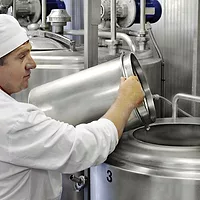Soleris® System Shown to Reduce Time and Cost for UHT/Aseptic Pack Testing
Neogen’s line of tests available for use with its Soleris® microbial detection system now includes a rapid assay for process monitoring in ultra-high temperature (UHT) production.
Neogen’s Soleris NF-105 total viable count (TVC) vial detects microbial contamination in UHT/aseptic production in as little as 72 hours, which represents a significant improvement from traditional testing methods that can require up to 14 days for results. Unlike testing using traditional methods, Neogen’s assay can also be used to test large sample sizes.
“The gold standard commercial sterility testing is a 7–10-day initial incubation of a UHT product in its carton, followed by a check for pH and package swelling, and often microbial plating using standard methods agar. If there is no contamination, the product is considered ready for market,” says Neogen’s Joe Heinzelmann. “However, this leads to production problems if contamination is persistent. Most plant managers want faster results to help keep problems in check—that is why Soleris is used to monitor processes. The system provides the most efficient method to determine what elements of production must be sequestered and put on hold for further testing.”
The Soleris system is a rapid optical method for the detection of microbial contamination based on an innovative application of classic microbiology. The optical assay measures microbial growth in test vials by monitoring biochemical reactions that generate a color change as microorganisms grow and metabolize.
Soleris technology monitors changes in the chemical characteristics of microbial liquid growth medium and detects microorganisms with carbon dioxide (CO2)-sensitive reagents. The reagents change their optical patterns as the metabolic process takes place. These changes are detected photometrically by an optical reader and monitored every 6 minutes.
“The Soleris system is an effective tool available for testing for sterility because after the initial incubation period, the system will detect microbial presence in products that other methods are too slow to detect or will miss completely,” Heinzelmann says. “Soleris will detect process deviations much faster and at less expense than other methods. The combination of faster results, sensitivity and low cost allows for maximally efficient UHT process monitoring.”
The Soleris nonfermenting TVC medium vials allow for greater inclusivity with a shorter detection time in sterility testing. As organisms grow in the broth medium, the CO2 produced diffuses through a membrane layer into a soft agar plug containing a dye indicator. The color change in the dye is read by the Soleris instrument. The membrane layer also serves as a barrier, eliminating product interference within the reading frame.
NF-105 vials are used as a method for detection of any heterotrophic bacterial microorganism. This makes Soleris a valuable diagnostic tool for real-time detection of a wide range of microorganisms in a variety of products.
Internal studies were conducted to validate optimal test procedures for the Soleris UHT and aseptic pack test system. The system used with NF-105 vials was shown to be more sensitive than traditional plating methods for UHT/sterility-based products. The increased sensitivity allows for positives to be detected an average of 3 days sooner compared to plates and allows for faster turnaround time and increased inventory turnover.
The studies used an injury procedure to mimic the effects of UHT/aseptic processing on microorganisms. Samples of UHT/aseptically packaged products were inoculated with heat and peroxide-injured Staphylococcus warneri, Pseudomonas aeruginosa and Bacillus circulans, which historically have been associated with UHT/aseptic packaged product deviations. The heat and peroxide exposure was varied between each organism to achieve the desired sublethal injury measurement.
The Soleris method was shown to provide quicker results and was found to be more sensitive than traditional plating methods for measuring microorganism growth in UHT products.
The production of fractional positives showed the Soleris system handled the challenge to its protocol well. In many cases, the system not only was more sensitive than the traditional plating method, but also detected bacteria in a shorter time frame. The average detection time in the Soleris vial was approximately 9 hours in more than 1,400 positive results compared to the 48-hour plate.
Statistical analysis showed the Soleris method is significantly more sensitive than the traditional method. Additionally, there was not a significant difference in 3-day incubation results using plates as compared to Soleris at the 2-day incubation. Based on Soleris’ average detection time of 9 hours, positive results were obtained at an average time of 57 hours versus the time-to-positive results on plates of 120 hours.
The data generated shows the Soleris NF-105 methodologies produce more rapid results than traditional plating methods, allowing for the quicker release of products, faster turnaround time and earlier real-time detection if products demonstrate above specification requirements.
For the full study, or more information, contact Neogen at 800.234.5333 or foodsafety@neogen.com.
Looking for quick answers on food safety topics?
Try Ask FSM, our new smart AI search tool.
Ask FSM →







